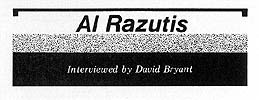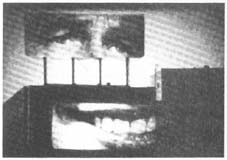Spiral #6, January 1986 
I first became aware of Al Razutis through his writing in Opsis: A Canadian Journal of Political and Avant-Garde Cinema Shortly thereafter, Amerika: The Sampler Reel (segments from a full length work) was screened as part of a concentration on Canyon Cinema sponsored and co-curated by the Portland State University Film Committee. These screenings had several purposes behind them: 1) to show films which had rarely (if ever) seen a theater in Portland; 2) to avoid the rental of pre-curated "summations " of the avant-garde (the greatest hits of experimental cinema approach); and 3) to critique the absence of such programming from the schedules of "film art" institutions (many of them now under the umbrella of NAMAC-an entity I find particularly threatening to the avantgarde/political/experimental filmmaker potential). Partially inspired by Al's explosive and demystifying writing and filmmaking, this interview will hopefully pinpoint some major issues facing the future of an avant-garde.-db

David Bryant: Who are the instigators of Opsis, what are the objectives for engaging in the publication of a magazine as encompassing as the first issue was, and what have been the difficulties and benefits encountered?
Al Razutis: Tony Reif and I founded Opsis to function as a forum for discussion and debate concerning issues arising from the study and practice of avant-garde and political cinema (their relationship is obvious to us). While our focus is first on Canadian films, we have always maintained an interest in American and international cinema and foreground much of this activity as well (see Issue No. 2). The publication intends to bridge the gap between the theoretical/academic, critical/analytical, biographical and historical and practice, and will continue to feature interviews, reviews of films and books, news, etc. Michael Eliot-Hurst joined us as co-editor shortly before the publication of Issue No. 1; Carolyn McLuskie also joined us as managing editor and greatly participated in the production of the first issue. Aside from our financial difficulties (which have produced numerous delays in publishing Issue No. 2), the strong anti-psychoanalytic position and critique of art elitism (and complicity in dealings with the Ontario Censor Board) have resulted in a kind of "blacklisting" by those academics and artists criticized in Issue No. 1. Some filmmakers also feel that the publication is too "academic" for their tastes, although I sometimes wonder, after seeing "art film" publications, whether they are proposing a model that is close to illiteracy of the film-catalogue kind. Our primary concern is to generate dialogue between those that study and those that produce films. At the present there is an incredible scarcity of serious writing by Canadians on Canadian art/film with the unfortunate result that the editors have had to contribute many of the articles.
B: How do you feel about the term "avant-garde"? Where does it place the avant-garde filmmaker; why is there such a distinction and what purpose does it serve?
R: I use the term avant-garde instead of the experimental because I think it better identifies the kind of cinema that I refer to-the political, the transformational, the artistic, and those historically linked to the other avant-gardes. I don't believe it is dead or has outlived its usefulness in shaking up the status quo. If ever there was a time where shaking up is necessary it is now, in the age of mass communication, mass propaganda, mass conformist lifestyles, an age that is dangerously close to holocaust. An art for this age is an art that responds, in part or in toto, or is at least conscious of the context, to these worldwide issues. "Experimental" to me connotes apolitical isolation, applied work.
B: What is your opinion on an approach to political filmmaking which disguises radical content within a framework of conventionality (e.g. "getting the facade of continuity right")?
R: I think this manner of "subverting" dominant ideology is both over-determined by (reductive) psychoanalysis to be of any theoretical use and is serving to reinforce dominant cinema codes unnecessarily and counterproductively. The argument that the avant-garde has to popularize itself to be mass consumable underestimates both its capacity to subvert at the mass scale and the intelligence (which is desired) of the "mass" audience.
B: It has seemed to me that in the past several years, a significant number of media institutions in the United States have avoided taking part in an organized (or even disorganized) investigation of film theory, history, and/or practice (as opposed to a random sampling, or greatest hits approach to curation), which has resulted in a situation where no questions are being asked in an effective manner about what is being exhibited. One possible reasoning might perhaps be a curatorial fear of alienating an audience with an "institutional academicism." How does such a positioning bode for the future of any investigative or avant-garde approach to filmmaking, and what sort of strategies are available to a filmmaker (or group of filmmakers) confronted by such obstacles?
R: Filmmakers and theorists have to communicate, not prescribe or hide and divide into their own cliques, as has happened with the theorists, all friends of a feather, attending conferences on "new narrative" and prescribing from this vantage point what is desirable, healthy, important and useful in cinema (i.e., films which illustrate their own points well-e.g. Bette Gordon, etc.). Filmmakers have to read and write more. There is no profit in avoiding the curator, academic, critic, and theorist-this is what happened in the underground cinema of the '60s and '70s: here we had people producing at a phenomenal level of energy, expanding the range of film, and refusing to theorize about it or "academicize" it or even "read" (as if that were ever an impediment to vision ! ). And across the Atlantic in France you had the development of the most reductive theories of the cinema imaginable based on linguistics, semiotics, Marxism, and ultimately based on theory itself. Like I said, theory and practice have to come together, to inform each other, and to get rid of the ridiculous and paranoid binarism that separates one from the other. The first step is to critique and perhaps neutralize the extremely dogmatic and reactionary form of film theory called "psychoanalytic feminism." If you read Constance Penley's article on the "Avant-Garde and its Imaginary," you would know what I mean.
B: The last question brings me to the censorship which faced your film A Message from Our Sponsor in Ontario, and your comment in Opsis that it seemed like the beginning of the end. Perhaps I am being idealistic, but it seems to me that an increased reliance upon film and video institutions as a source of recognition for the artist has arisen (the syndrome of getting your work in the right places in order to be recognized by the right funding organizations, and thereby becoming a perpetuated artist). This situation leads to several problems, the most outstanding in my opinion being the creation of an economical rift between filmmakers where everyone fights for only themselves. An additional problem has been described to me by a filmmaker as a closed ring, where NEA funded institutions show and promote NEA funded films, which creates a stasis of NEA funded artists. It seems to me that the problem of individuals and institutions grabbing what they can for themselves is very similar to the "end" you described for the censorship issue: a different problem, the same reaction. To further pinpoint the issue, it seems the "end" could be described as a situation where national media arts centers assume their presence as essential, vital to the furtherance of the arts, to the point of becoming detrimental to the filmmaker and artist. Whereas in actuality, they increasingly play the role of middleman in an economic chain. The resulting effect is that the artist moves from producer to commodity. No longer is solely the film the commodity; now the filmmaker must be saleable as well. If this assessment is accurate, it seems useless to at this point seek origins, lay blame, etc. Such a course of action offers little more than a distraction, a sidestepping, when the goal should be a description of the situation, which in turn could lead to options for anyone (filmmaker, institution member or administrator, funding agency) who feels caught in such a double bind.
R: The NEA is an excellent example, paralleled in Canada by our own Canada Council. C.C. funds films, funds exhibition houses, funds advertising these films, and may as well fund the cab fare for people to go and see them. Does this improve (aside from the simple economic matter of keeping some people from starving) the art or does it (as Mekas asserted in the recent Experimental Film Coalition newsletter) support trivialization and conformism. I think it does both, depending on many factors: who's picking the juries, who they are, what kind of grant funding policy is in place, how does the institution exert its influence (ideological and unconscious) on the art. In Canada in film and video we have seen during the '70s the erasure of videosynthesis by the regressive policies of video officers, the generation of 1 16mm film craft industry masquerading as "art," the inability of the C.C. to support experimental film in spite of some good intentions, and generally a fiasco not conducive to development and support of film as art. Political cinema has fared even worse, and the National Film Board in the seventies turned out to be a bureaucratic and overfed animal that benefited primarily the executive process and in-house people and stifled, frustrated, or compromised any good works (with the exception of some feminist lobbies). Once again, operating at the level of production, exhibition, and distribution, it killed the very offspring the that it was mandated to support. And most people are so cowardly that no criticism of any public kind (a lot of apologists, waiting their next turn at the decision making level) was visible for years, only rumors, allegations, and silence. This kind of crap has now made its way into the infrastructure of most bureaucracies and government agencies. This is where many artists are motivated (if they are going to survive) to play politics with these agencies. This is why a lot of people give up . . . this is why nothing changes.
B: What about alternative screenings, collective bargaining, and especially, with the emergence of cable, the possibility of broadcast as a method of direct access to audiences?
R: Alternative screenings are a necessity if the avant-garde is to resist being institutionalized by the government, grant agencies, commercial interests, the university, etc. Collective bargaining at the level of an open shot (not closed you're in you're out!) where boycott, if necessary, is implemented in the case of exhibition houses not paying artists . . . we tried this in Canada several years ago when I attempted to create a Canadian Film-Artists Association with members of the Funnel in Toronto. We discussed basic rates for screening, a pay scale similar to that of Canadian Artist's Representa tion, which has succeeded in negotiating at least reasonable exhibition fees for artists (the basic wage as it were). We discussed boycott, we discussed all kinds of political and economical things, and the whole notion and organization collapsed because a) artists were too insular to care; b) they were too poor to resist the temptation of the meager handout and many were horrified by boycott strategies; c) many are greedy for individual fame and fortune at the expense of everyone else . . . it was a sorry sight. Cable and television, contrary to the paranoia exhibited by many experimental film purists, is a legitimate and important venue for experimental films. Most distributors are slow in moving into it and most artists are too obsessed with their own work to figure out a means of entry into this market that may be both business-like and beneficial to others.
